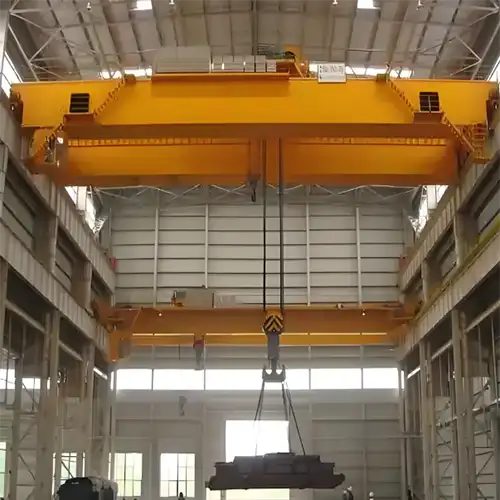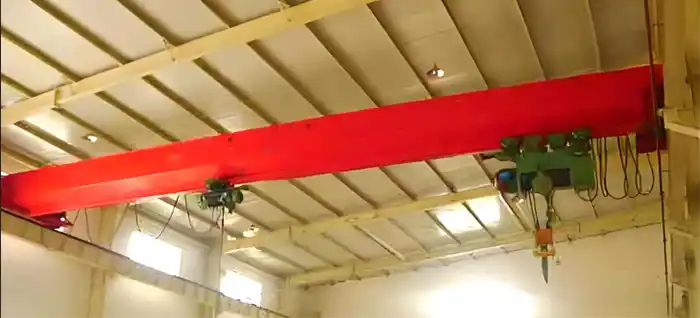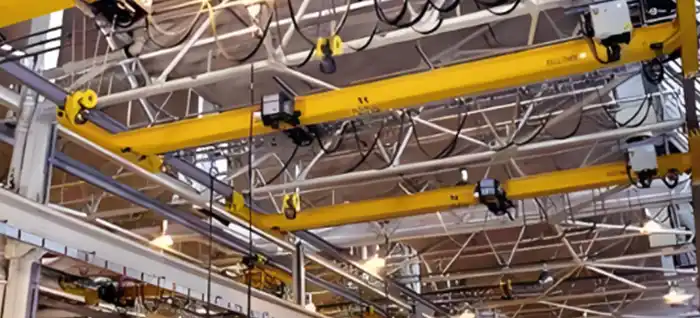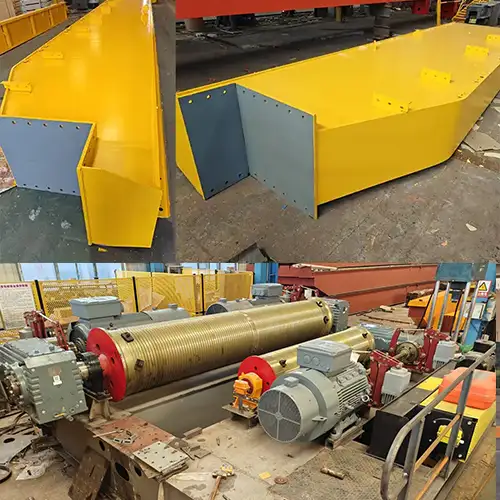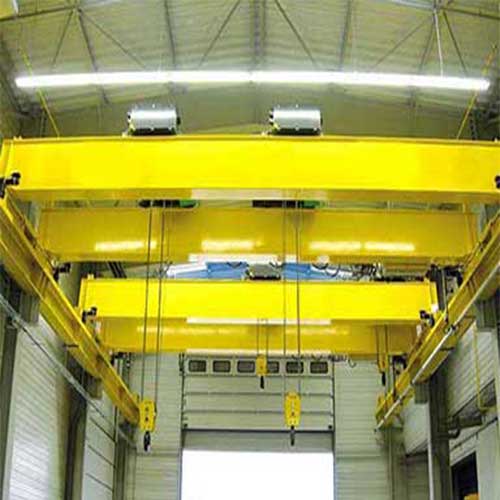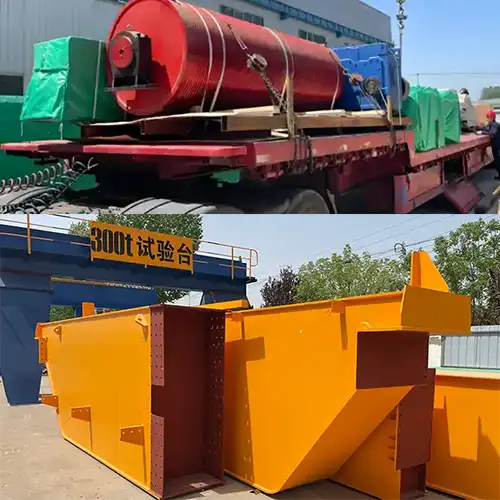Overhead Cranes with Two Hooks for Sale: Types of Cranes & Cost
Overhead Cranes with Two Hooks for Sale: Types of Dual-Hook Cranes & Cost Considerations. Model Line-Up, Real-World Cost Breakdowns, and Smart Buyer Tips.
Category: Heavy Duty & Large Capacity
Your Trusted Overhead Crane Manufacturer & Supplier
Overhead Cranes with Two Hooks for Sale: Types of Dual-Hook Overhead Cranes And Cost Considerations
Model Line-Up, Real-World Cost Breakdowns, and Smart Buyer Tips
Introduction-Cost Considerations When Investing in an Overhead Crane with Two Hooks
What is a dual-hook overhead crane ?: It's an overhead crane equipped with two hooks — a main hook and an auxiliary hook. The main hook lifts heavy loads, while the auxiliary hook handles lighter or smaller items. This setup helps when you need to switch between different load sizes quickly or even lift two different loads at once.
Why should buyers care about costs?: Because the price tag isn't the whole story. Beyond buying the crane, you'll face costs for installation, upkeep, energy, and even training operators. These expenses can add up and affect your budget more than you expect.
What will this guide do for you?: It breaks down the main cost factors related to dual-hook cranes. The goal is to give you a straightforward look at what you need to budget for — from purchase to maintenance — so you can make smart buying decisions without surprises.
Your Trusted Overhead Crane Manufacturer & Supplier
Overhead Cranes with Two Hooks
Types of Overhead Cranes with Two Hooks (Within One Trolley)
If you're considering an overhead crane with two hooks, there are several configuration options available — especially where both hooks are mounted on the same trolley. This setup is useful for handling asymmetrical loads, lifting long items at two points, or switching between heavy and light lifting tasks without changing equipment.
Overhead Crane with Two Hooks in One Trolley
This is a general-purpose crane with two hooks operating side by side on a shared trolley. It allows the operator to lift with either hook independently or use both together for balanced handling of long or unsteady loads.
- Practical for fabrication shops, assembly lines, and mechanical maintenance
- Commonly used in workshops where both heavy and auxiliary lifting tasks are required in one bay
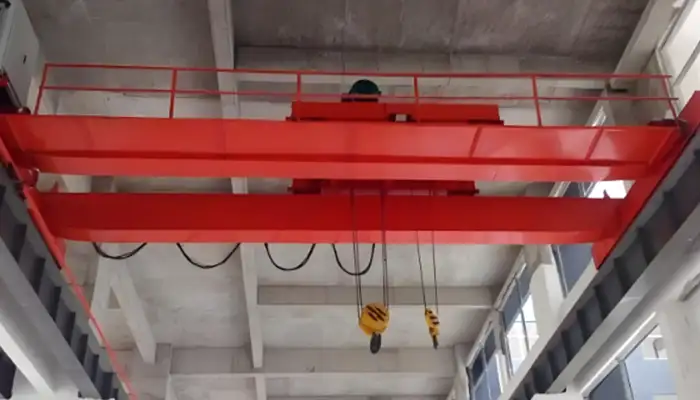
Economical Electric Hoist Overhead Crane (Two Hooks, One Trolley)
This version uses two electric wire rope hoists mounted on the same trolley beam — a budget-friendly solution for lighter-duty applications.
- Ideal for workshops, small warehouses, and maintenance areas
- Cost-effective for basic lifting without advanced automation
- Easy to install and maintain
- Common capacities: 2-ton + 2-ton or 5-ton + 3-ton setups. Check 40/15 ton overhead crane with two hooks , 20 ton/ 2 ton overhead bridge crane with two hooks project for your reference.
Buyer tip: Great for low-frequency users who need basic two-hook functions without high costs.
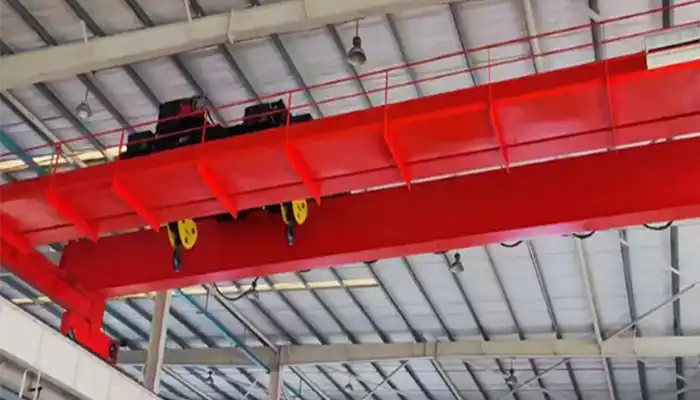
European-Style Low Headroom Electric Hoist Crane (Two Hooks, Crane Crane with Main hook and Axuliary Hook within One Trolley)
This setup uses compact European-standard electric hoists designed for facilities with limited headroom.
- Optimized for low ceiling spaces and high hook travel
- Offers smoother lifting, precise speed control, and quiet operation
- Often comes with frequency inverters for both lifting and traveling
Best suited for: Facilities with modern infrastructure, tighter vertical space, and higher demands for ergonomic operation. Check 15/10 ton overhead crane with two hooks within one trolley for your reference

Economical Open Winch Overhead Crane (Two Hooks, One Trolley)
Instead of hoists, this crane uses two open winch mechanisms mounted on a single trolley. It's a heavier-duty system, usually seen in medium to large manufacturing plants.
- Designed for higher capacities (e.g., 20-ton + 5-ton) or large-span workshops
- Offers easy maintenance and strong structural durability
- Basic controls but solid performance for general industrial use
Why choose this type? A good middle ground between cost and heavy-duty lifting needs.
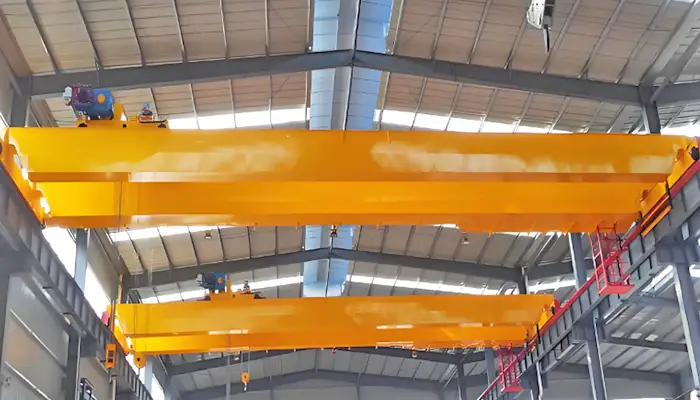
European-Style Low Headroom Open Winch Overhead Crane (Two Hooks, One Trolley)
This is the high-end version, combining open winch technology with low headroom design and European-style engineering.
- Offers top performance in terms of lifting height, speed regulation, and system integration
- Used in advanced manufacturing, energy plants, heavy equipment workshops
- Higher initial cost but longer service life, less vibration, and more precise control
Recommended for: Buyers needing high-capacity lifting under tight space limitations with minimal operational noise and smooth control.
Types of Gantry Cranes with Two Hooks (Within One Trolley)
When both hooks are mounted on a single trolley, the design becomes compact and ideal for long load handling. Below are the most common configurations, categorized by their hoisting systems.
Gantry Crane with Two-Hook Electric Hoist Trolley
This type uses two standard electric wire rope hoists, mounted side by side on one trolley frame.
- Use Case: Light to medium-duty applications requiring basic dual-point lifting.
- Common Capacity: 5 ton + 5 ton, 10 ton + 10 ton.
Features:
- Affordable and simple in structure.
- Easier to install and maintain.
- May offer limited synchronization between hooks.

Gantry Crane with Two-Hook European-Style Hoist Trolley
Fitted with two compact European-style wire rope hoists on a shared trolley, offering better control and efficiency.
- Use Case: Workshop or yard environments that require compact design and smooth, precise operation.
- Common Capacity: 5 ton to 20 ton per hook.
Features:
- Frequency inverter (VFD) for smoother hoisting and traveling.
- Lower wheel load and modular design.
- Better synchronization and energy savings.
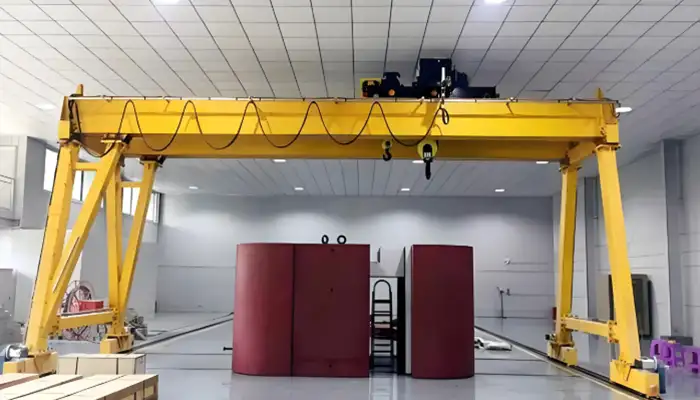
Gantry Crane with Two-Hook Open Winch Trolley
Two heavy-duty open winches are integrated into a single trolley frame for handling large and heavy loads.
- Use Case: Suitable for shipyards, steel plants, and other heavy industries.
- Common Capacity: 30 ton + 30 ton, 50 ton + 50 ton and higher.
Features:
- Robust structure for tough working environments.
- Powerful winch motors and large drums for long lifting height.
- Built for frequent, heavy-duty operations.

Gantry Crane with Two-Hook European-Style Open Winch Trolley
A high-end configuration combining open winch performance with European precision and efficiency.
- Use Case: Demanding projects such as energy, aerospace, or marine component handling.
- Common Capacity: 20 ton + 20 ton to over 100 ton.
Features:
- High-precision VFD-controlled winches with encoder feedback.
- Compact and efficient structure.
- Excellent for delicate, high-precision, and high-load applications.

Overhead Cranes with Two Hooks and Two Trolleys
When two lifting points are needed to operate independently — such as lifting and rotating long beams, or coordinating two different load areas — an overhead or gantry crane with two trolleys, each equipped with its own hook, offers a flexible and powerful solution.
Single Girder Overhead Crane with Two Trolleys and Two Hooks
Economical Type:: This budget-friendly version uses two compact electric hoists mounted on separate trolleys that move along the same single girder. It's a practical choice for light to medium-duty applications where separate lifting is occasionally needed.
- Lower lifting height due to underhung hoists
- Simple control system (independent pendant or radio control)
- Common capacities: 2-ton + 2-ton or 5-ton + 3-ton setups
- Ideal for small fabrication shops or part-handling lines
European Crane Design:: Uses low-headroom European-style hoists for better lifting height and smoother operation. This version offers more advanced control (frequency conversion) and lower noise.
- Compact trolley design to save vertical space
- Suitable for cleaner, modern industrial workshops
- Better suited for operations that require gentle load handling or frequent cycling
Double Girder Overhead Crane with Two Trolleys and Two Hooks
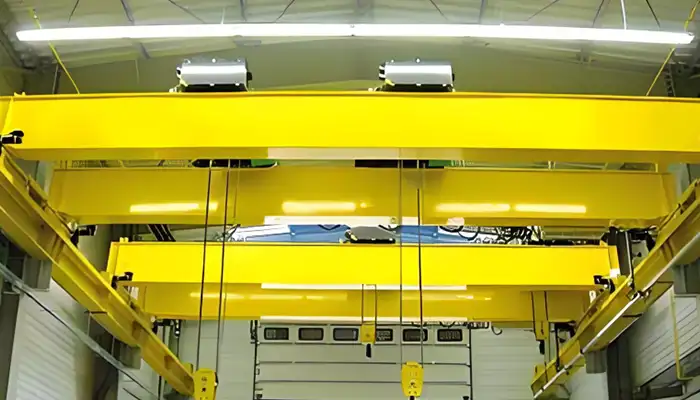
Economical Type: Overhead crane with two hook and trolleys Equipped with two standard open winch or electric hoist trolleys on the same bridge. Cost-effective for general industrial use where loads need to be moved independently or in tandem.
- Robust steel structure, standard control
- Basic dual pendant or cabin control available
- Common for large part assembly or machine shops needing two-point lifting Click to chek 40 ton + 40 ton overhead crane with two hooks with with crane trolley , economical 3 ton + 3 ton electric hoist overhead crane for your reference, etc.
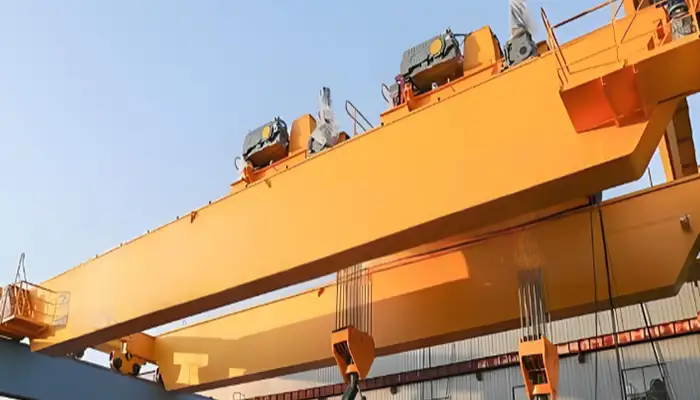
European Crane Design: It is an overhead crane with two hooks and two open winch trolley. A premium option that combines modular trolleys, inverter-controlled motors, and precise load synchronization if required.
- Excellent for aerospace, heavy equipment, and energy industries
- Improved maintenance access, load positioning, and operator comfort
- Fully configurable for tandem operations or automated routines. 25 +25 ton overhead crane with two hook two trolley project, 200 ton + 200 ton overhead crane with two open winch trolley project for your reference.
Gantry Cranes with Two Hooks and Two Trolleys

Single Girder Gantry Crane with Two Trolleys and Two Hooks
Economical Type:: Two independent hoists on separate trolleys run along a single box girder. Suitable for outdoor or semi-outdoor use in yards handling light steel structures, pipes, or small containers.
- Freestanding or rail-mounted designs
- Weatherproof hoists available
- Typically used in medium-size fabrication or storage yards

European Crane Design:: Compact European hoists on modular gantry frames allow better hook approach and more reliable travel, especially for sites with limited space.
- Lower noise and higher lifting precision
- Available with VFD for soft start/stop motion
- Ideal for modern construction material handling
Double Girder Gantry Crane with Two Trolleys and Two Hooks
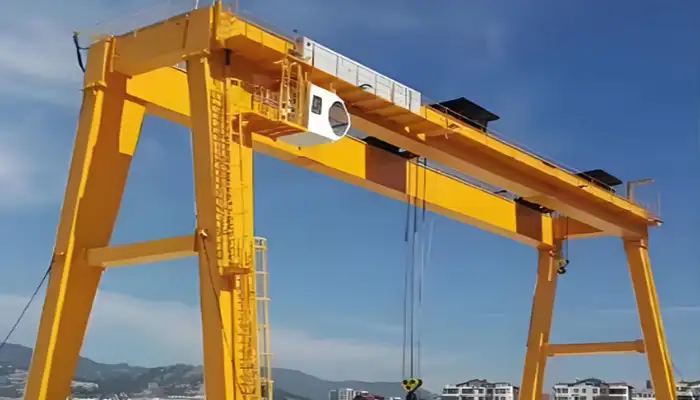
Economical Type: This version uses standard trolleys (open winch or hoist type) on a strong twin-beam gantry frame. It's popular in large yards, shipyards, and steel storage facilities.
- Common capacity ranges: 10 + 10 tons, 20 + 10 tons
- Rail or track-mounted with basic weather protection
- Separate operation of each trolley, or optional master control panel
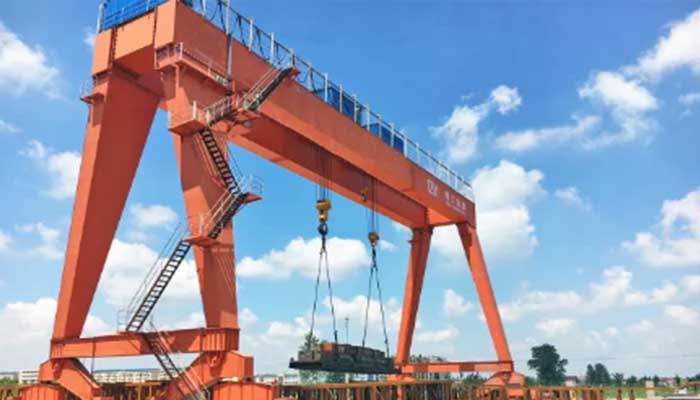
European Crane Design: For buyers needing high performance and precise synchronization, the European type provides advanced features.
- Modular open winch trolleys with programmable logic
- High anti-sway performance, even under strong winds
- Designed for 24/7 operations in heavy-duty environments
Two-hook, two-trolley cranes give buyers more control and lifting flexibility — ideal for long, awkward, or multi-point loads. Choosing between economical vs. European-style designs depends on your lifting frequency, precision needs, and budget. Contact us to get the cost-effective solution for your needs.
Comparison Table: Types of Overhead Cranes with Two Hooks
| Crane Type | Design | Trolley Configuration | Hoisting Mechanism | Key Features | Typical Applications |
|---|---|---|---|---|---|
| Overhead Crane (Two Hooks in One Trolley) | Economical Electric Hoist | One trolley, two hoists | Wire rope hoists | Cost-effective, basic controls, compact structure | Workshops, maintenance, light-duty lifting |
| European Low Headroom Hoist | One trolley, two hoists | European low-headroom hoists | Improved lifting height, inverter control, smooth operation | Facilities with low ceilings, frequent precise lifting | |
| Economical Open Winch | One trolley, two winches | Open winch mechanism | Higher capacity, rugged design, simple operation | Steel structures, mid-duty manufacturing | |
| European Low Headroom Open Winch | One trolley, two winches | Compact winch trolleys | Compact footprint, quiet movement, precise lifting | Automotive, energy, machinery assembly lines | |
| Overhead Crane (Two Hooks in Two Trolleys) | Single Girder – Economical | Two trolleys, each with a hook | Dual hoists or winches | Simple control, basic structure, affordable solution | Light fabrication, split-load handling |
| Single Girder – European | Two compact trolleys | European electric hoists | Low headroom, improved precision, modular design | Assembly workshops, moderate industrial use | |
| Double Girder – Economical | Two trolleys, independent | Standard hoists or winches | Heavy-duty structure, standard speed, reliable | Large workshops, machine handling, steel plants | |
| Double Girder – European | Two advanced trolleys | European open winch | Advanced controls, anti-sway, programmable motion | High-performance manufacturing, precision handling environments | |
| Gantry Crane (Two Hooks in Two Trolleys) | Single Girder – Economical | Two trolleys | Electric hoists | Freestanding use, weather-resistant, basic operation | Outdoor storage yards, construction material handling |
| Single Girder – European | Two compact trolleys | European hoists | Efficient use of space, soft start/stop control | Prefab yards, modern building sites | |
| Double Girder – Economical | Two trolleys | Open winches | Strong load capacity, basic controls, long span design | Steel depots, heavy lifting in industrial zones | |
| Double Girder – European | Two advanced trolleys | European winches | Synchronization options, advanced safety, remote operation | Port terminals, wind turbine yards, aerospace fabrication |
Notes:
- Trolley Configuration::
"Two hooks in one trolley" means both hooks operate together on a single carriage — best for long or unbalanced loads.
"Two hooks in two trolleys" means the hooks operate independently — ideal for multi-point lifting, turning, or managing different loads at once. - Design Type (Economical vs. European)::
Economical types prioritize basic function and affordability.
European-style cranes are built for higher lifting efficiency, tighter space conditions, smoother operation, and improved safety features.
Your Trusted Overhead Crane Manufacturer & Supplier
Types of Costs Involved (For Overhead Cranes with Two Hooks)
Initial Purchase Cost
Buying an overhead crane with two hooks—whether they're mounted on one trolley or two—typically costs more than a standard single-hook crane. Here's why:
More components, more complexity: A dual-hook system has either:
- Two hoists mounted on one trolley (common in economical or European-style compact cranes), or
- Two separate hoists on two trolleys (common in double girder cranes).
Both layouts mean extra motors, gearboxes, control wiring, and load handling equipment—this adds to the base price.
Hook capacity directly impacts price:
If both hooks are designed to lift heavy loads (e.g., 10 tons each), you'll need stronger beams, hoists, and brakes—raising the cost.
If the auxiliary hook has a smaller capacity (e.g., 2–3 tons), you can keep the budget lower while still gaining functionality.
Customization increases cost: For example:
- Independent or synchronized controls
- Specialized lifting attachments for each hook
- Enhanced hook spacing for lifting long loads
These all enhance performance but come at an additional cost.
Material, brand, and certification: European-style cranes often use higher-grade steel, advanced electronics, and include CE/ISO compliance—costing more than standard economical cranes.
Key advice:: Be realistic about what your application actually needs. Don't overspend on dual 10-ton hooks if you rarely lift over 5 tons. Ask your crane supplier to recommend a model that meets your load types and frequency.
Installation Costs
Installing a two-hook overhead crane comes with added complexity, especially for systems with two trolleys or heavy-duty dual open winch hoists.
Structural reinforcements may be necessary:
If you're using a double girder overhead crane with two hooks (especially with two trolleys), your runway and supporting structure must carry higher dynamic and static loads.
Retrofitting an older workshop may involve reinforcing columns, beams, or foundation pads.
Complex wiring and controls: Dual-hook cranes require:
- Additional power cables
- Dual pendant or radio controls
- Safety circuits to prevent hook interference
More installation time, more labor costs.
New construction vs. retrofitting:
Installing a crane during the construction of a new building lets you plan for runway length, clearance, and hook drop.
Retrofitting into an older space, however, might require costly modifications to make the dual-hook layout fit.
Pro tip:: Schedule a pre-installation structural and electrical audit. It's the best way to avoid costly surprises once installation begins.
Operational Costs
Daily operation of a two-hook crane involves more than just pressing buttons. You're managing two hoists, which affects your bottom line.
Higher energy consumption: Whether you're using a single trolley crane with two hoists or a twin-trolley crane, each hoisting unit draws power. Even when idle, dual systems can increase your power bill.
Increased maintenance needs: Two sets of lifting equipment = twice the inspections. Expect to service:
- Two motors
- Two braking systems
- Two sets of wire ropes
- Hook blocks and safety mechanisms
Preventive maintenance becomes more frequent—and costlier.
Operator training: Workers need to understand how to:
- Switch between main and auxiliary hooks
- Synchronize dual lifts safely
- Avoid hook collisions or unbalanced loads
Training is essential, especially for European cranes with more advanced control systems.
Remember:: Operational costs don't show up on the purchase invoice, but they make a huge impact over 10–15 years of crane use.
Maintenance and Repair Costs
Two-hook cranes require a more involved maintenance routine.
Spare parts planning: Keep stock of spares for each hook: motors, brakes, cables, and safety relays. For example:
- Open winch systems may need more frequent rope drum or gearbox maintenance.
- Electric hoist models may require fewer spares but still need consistent upkeep.
Inspection costs increase: Safety regulations usually require third-party inspections. Each hook system must be tested individually, so certification time (and cost) increases.
Risk of downtime: One broken hook can take the whole crane out of service. If a main hoist fails on a two-trolley double girder crane, you may lose an entire production day.
Practical advice:: Develop a hook-specific maintenance log. Track wear separately for each system—don't assume they degrade at the same rate.
Auxiliary Equipment and Accessories
Don't overlook the additional items you'll likely need when setting up a two-hook crane.
Advanced control systems: Most European-style dual-hook cranes come with digital pendants or radio systems allowing you to:
- Operate each hook separately
- Sync both hooks for balanced lifting
- Add programmable logic for lift coordination
Extra safety features: To prevent hook collision or overload, you may need:
- Load moment indicators (LMIs)
- Interlock systems
- Sway control for large-span gantry cranes
Dedicated lifting attachments: Some jobs require hook-specific gear. You might use:
- A magnet on the auxiliary hook for small pieces
- A C-hook or clamp for the main hoist to handle coils or slabs
Having the right tools boosts efficiency but adds to your setup budget.
Tip:Plan the full lifting system—not just the crane. Your supplier can help spec out attachments and controls that match each hook's purpose.
Simple Cost Comparison Table: Overhead Cranes with Two Hooks
| Crane Type | Initial Cost | Installation Cost | Running Cost | When to Choose | Pros | Cons | Customization Options |
|---|---|---|---|---|---|---|---|
| Electric Hoist Crane (Economical) - 2 hooks in 1 trolley | Low | Low | Low | Small workshops, simple loads, budget-friendly | Easy to install and operate | Limited lifting capacity | Basic controls, standard hooks |
| European Low Headroom Electric Hoist - 2 hooks in 1 trolley | Medium | Low | Low | Indoor spaces with low ceilings | Space-saving, smooth operation | Higher initial cost | Advanced controls, overload protection |
| Open Winch Crane (Economical) - 2 hooks in 1 trolley | Medium | Medium | Medium | Medium-duty lifting, general manufacturing | Robust and flexible | More maintenance needed | Variety of hooks and attachments |
| Single Girder Crane with 2 Trolleys (Economical) | Medium | Medium | Medium | Mixed load types, moderate budget | Independent hook control | Limited heavy load capacity | Customized spans and controls |
| Double Girder Crane with 2 Trolleys (European) | High | High | Medium-High | Heavy-duty, precise lifting, demanding environments | High stability, long lifespan | Higher upfront and installation cost | Full customization, safety features |
| Single Girder Gantry Crane with 2 Trolleys (Economical) | Medium | Medium | Medium | Outdoor lifting, construction sites | Easy to move, cost-effective | Lower precision | Customizable trolley setups |
| Double Girder Gantry Crane with 2 Trolleys (European) | Very High | Very High | Medium-High | Heavy outdoor lifting, steel mills, ports | Excellent durability and control | Expensive, complex installation | Advanced control and safety systems |
Why this works better for buyers:
- Clear buying guidance: The "When to Choose" column helps them immediately see which cranes suit their specific needs.
- Balanced pros and cons: They get an honest view, which helps build trust.
- Customization info: They know what can be tailored, helping them plan ahead.
- Cost transparency: Showing installation and running costs alongside purchase price helps avoid surprises.
Cost-Benefit Analysis of Different Two-Hook Overhead Crane Types
Choosing a two-hook overhead crane isn't just about paying more—it's about what that second hook allows you to do. From simpler hoist-based systems to precision European winch models, understanding the cost-benefit relationship comes down to how you plan to use the crane.
Greater Flexibility, Especially with Two Trolleys
- Cranes with two hooks on two trolleys (especially double girder types) give you the flexibility to lift two separate loads or long items with multiple lifting points.
- For example, a double girder crane with two trolleys can lift a long steel beam using both hooks for balanced handling, or use each hook independently for different parts of the job.
- This reduces idle time, avoids the need to reposition equipment, and simplifies certain tasks—especially in fabrication shops, equipment yards, or heavy assembly lines.
Time Savings in Dual Lifting Operations
- When using two hooks on the same trolley (often found in economical or low headroom designs), you benefit from simultaneous lifting of primary and auxiliary loads.
- While not fully independent like dual-trolley systems, this layout helps in lifting one heavy load with the main hook and a secondary item with the auxiliary—saving operator time between lifts.
- These small time savings add up across shifts, especially in repetitive or production-based workflows.
Workflow Efficiency and Return on Investment
- European-style two-hook cranes, whether overhead or gantry, are often more expensive upfront but offer precise control, smoother motion, and safer operations. These improvements directly affect productivity and reduce maintenance interruptions.
- Over time, the added investment in advanced control systems, inverter drives, and anti-sway features results in smoother operation and fewer load swings, which means less risk of damage and more efficient cycles.
- In comparison, economical types may require more operator attention and offer fewer automated features, but still serve well for applications where precision is not the main concern.
Choosing Based on Usage and Load Variation
- If your lifting needs frequently involve long or awkward loads, two trolleys are the better choice.
- If you mostly lift mixed weights in compact areas, a dual-hook single trolley crane might be enough.
- Gantry crane versions with two hooks are especially beneficial for outdoor or yard environments where large and long items like pipe bundles, steel plates, or prefabricated sections are handled.
The key to justifying the extra cost of a two-hook crane—whether you're buying a budget single girder hoist model or a high-end European double girder open winch crane—is matching the crane type to your operation. Buyers who choose based on real workflow demands, not just specifications, tend to see a better return over the life of the crane.
Financing and Total Cost of Ownership (TCO)
When thinking about buying a dual-hook overhead crane, it's important to look beyond the initial price tag. How you pay for the crane and what it will cost you over its entire life can make a big difference in your budget and decision.
- Financing or leasing options:: Not every buyer has the cash upfront to buy a crane outright. Many suppliers and financial institutions offer financing plans or leasing options. Leasing can lower your initial outlay and help manage cash flow, but it might cost more in the long run. Financing loans spread the cost over time but add interest expenses. Consider what fits your company's financial situation and goals best.
- Long-term costs vs. short-term savings:: It's tempting to choose the cheapest crane or installation option to save money right now. But lower upfront costs can mean higher maintenance, energy, or downtime costs later. Conversely, investing more initially in a reliable, well-designed crane might reduce repair bills and energy use. Look at the total cost of ownership — including purchase, installation, operation, maintenance, and eventual replacement — rather than just the sticker price.
- Resale value for specialized cranes:: Dual-hook cranes are more specialized than single-hook models, which can affect resale value. On one hand, the extra features and capacity can attract buyers who need that flexibility. On the other hand, if your crane is heavily customized for your plant, it might be harder to sell or worth less on the market. Keep this in mind if you plan to upgrade or replace your crane down the line.
Key takeaway:: A smart buying decision involves balancing how you pay for the crane and understanding what it will cost you over the years. Planning for the total cost helps avoid surprises and protects your investment.
Factors Affecting Cost Variation
Several factors influence how much a dual-hook overhead crane will ultimately cost. Understanding these can help you plan your budget more accurately.
- Crane capacity (tonnage) for each hook:: The lifting capacity of both the main and auxiliary hooks is one of the biggest cost drivers. Higher tonnage cranes require stronger materials, more powerful motors, and heavier-duty components — all of which increase the price. Even if the auxiliary hook is smaller, its capacity needs to be carefully chosen to match the types of loads you'll handle.
- Span and runway length:: The width of the area the crane needs to cover (the span) and the length of the runway beams impact cost significantly. Longer spans require larger, heavier girders and stronger support structures. Extended runway lengths mean more rails, wheels, and electrical components, which add up. The complexity of the installation also rises with size, driving up labor and material costs.
- Control system type:: Control options range from simple manual pendant controls to semi-automatic or fully automatic systems. Manual controls are less expensive but may slow down operations and require more skilled operators. Semi-automatic systems add convenience and safety features at a moderate price increase. Fully automated cranes offer the highest efficiency but come with a premium cost due to advanced sensors, software, and integration.
- Environmental and safety compliance:: Cranes used in special environments—such as hazardous zones (explosive atmospheres), outdoors with weather protection needs, or clean rooms—need extra design features. These include explosion-proof electrical parts, corrosion-resistant coatings, or dust-tight enclosures. Meeting local safety regulations can also mean extra certifications, inspections, and equipment, all adding to the overall cost.
Cost can vary widely depending on your specific application. By carefully considering your capacity needs, facility size, control preferences, and environmental conditions, you can choose the right crane configuration that balances cost with performance.
Practical Tips for Buyers of Overhead Cranes with Two Hooks
Investing in an overhead crane with two hooks requires careful planning. Here are some practical tips to help buyers make the right decision and get the most value from their purchase.
- Assess your actual lifting requirements for dual hooks:: Analyze the types of loads your facility handles daily. Determine if you need both hooks to have high lifting capacities or if the auxiliary hook can serve lighter tasks. This avoids overspending on an overhead crane with two hoists that exceeds your operational needs.
- Consult crane manufacturers for customized dual-hook crane quotations:: Share your facility layout, lifting capacity needs, and workflow details. Reliable suppliers of two-hook overhead cranes will offer tailored solutions that match your specific requirements, including hook configuration and control options.
- Include hidden costs like operator training and downtime:: Operating an overhead crane with dual hooks involves more complexity than single-hook cranes. Budget for comprehensive operator training on switching between hooks and coordinated lifts. Also, consider potential downtime during installation and maintenance of the two-hook system.
- Plan for scalability and future expansion:: Choose an overhead crane with two hooks that can accommodate future increases in load capacity or changes in workflow. Flexible crane designs with modular features help you adapt without costly full replacements.
In short:: A well-chosen dual-hook overhead crane that matches your real needs, with all costs considered, will deliver better efficiency and protect your investment over time.
Conclusion
When investing in an overhead crane with two hooks, understanding the full range of cost factors is essential. From the initial purchase price and installation to ongoing operation and maintenance, every stage has expenses that impact your budget.
Balancing the upfront investment with the long-term benefits — like increased productivity, flexibility, and efficiency — is key. Dual-hook cranes can offer real advantages, but only if the costs and operational needs are carefully matched.
Before making a final decision, take the time to perform a detailed cost analysis. This helps ensure you choose the right dual-hook overhead crane that fits your facility's needs and provides the best value over its lifespan.
Related Products
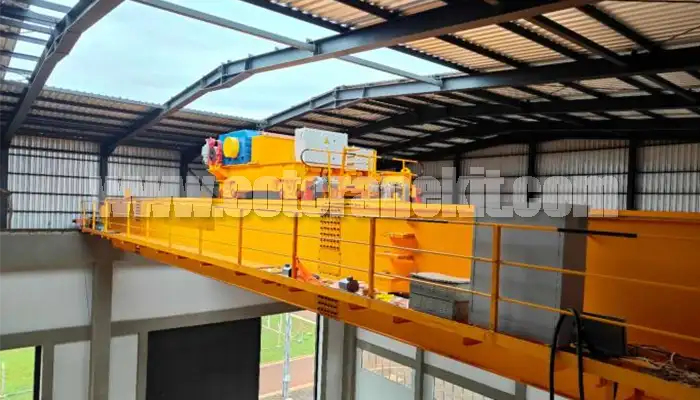
Latest project
150 Ton Overhead Crane Installation Feedback – Paraguay Case
QDX 150 ton overhead crane in action in Paraguay. Installation photos, video, and client feedback show performance, safety, and heavy-lifting efficiency.
Free consultation to Confirm Parameters & Specifications and Get
Latest Crane Price & Crane Rate.
- Types of overhead cranes : _______?
- Optional: Overhead travelling crane, goliath gantry crane,Slewing jib crane, Single girder or double girder crane,small portable crane or kbk crane, etc.
- Capacity of overhead crane: _______?
- Optional: 0.25ton, 0.5 ton, 1 ton, 2 ton, 3ton, 5 ton, 10 ton,15ton, 20ton, 25 ton, 30ton,35ton, up to 550ton, etc.
- Crane span & lifting height : _______?
- Crane travelling length : _____?
- Control of overhead crane:_______?
- Optional: pendant/ remote/cabin control
- Voltage supply of overhead crane:_____?
- Eg,: 380V50/60HZ,3Phase or others,etc.
- Application/usage of crane:_______?
- Eg,: Steel mill, ,injection mold, cement,stone, concrete,granite, general manufacturing, etc.
Just leave a message via the contact form and our hoist and crane engineer will contact you with in 24working hours.
Get In Touch
